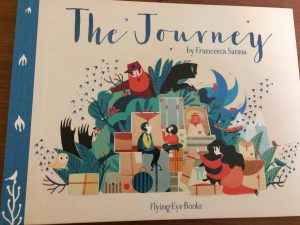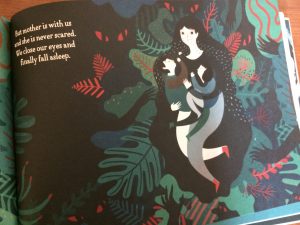The Journey
Written and illustrated by Francesca Sanna
Flying Eye Books, 2016
40 pages, Realistic Fiction
The Journey is a story about a family who lives in a country plagued with war and the consequences of wars. The narrator, a small child, describes his or her family’s experience with living in a war-torn country. The family is composed of a father, a mother, a boy, and a girl, but the father dies during the war. The mother hears about a way to escape, and she and the children plan to escape to find a better way of life in a different country. As the family travels to safety, they lose many of their belongings, and they are initially turned away by guards at the border. After paying someone to sneak them across the wall, the mother and her children board a boat to take them across the sea. Once they reach land, they travel by train to another location, and the book ends before the children reach their new home.
This book can be a window for children who are not familiar with the refugee crisis or the harshness that refugees face when they try to leave their country to save their lives. Reading this book with students, young and old, can be a beneficial way to discuss current events and the horrors of war. For students who are refugees or students who have faced persecution in a different way, this book is a mirror for their lives and shows how other people have faced a similar situation. The ideological perspective of The Journey shows children that there are times when even grown-ups, like the mother in this story, do not have the power to provide for their families. Sanna also takes the position that helping refugees is a positive thing to do, as shown by the villainization of the border guards.
The illustrations of this book look like collage, and there is an emphasis on bold colors. For example, the war is depicted as a black, formless being with hands that spreads over the pages, symbolizing the darkness and far-reaching effect of the war’s horrors. The characters are usually depicted as very small, especially in comparison to the war and the guards; the focus is usually on the nature around them or the belongings that they have with them. For the most part, the illustrations add to the text, providing additional details about the plot and the setting, but there are some occasions where the illustrations conflict with the text, most notably when the child says that Mother is not scared. The child believes that Mother is fearless, but when the children are sleeping, the mother is drawn with tears streaming down her face. This illustration fills in the reader that the mother is making sacrifices and pretending to be fearless in a horrible situation.
Sanna, the author, includes an author’s note at the end of the book where she describes her inspiration from the story. She talked with some refugees in Italy, and she realized that she wanted to write a story that provided voices to these characters. There is also a link to more information about refugees, courtesy or Amnesty International.



